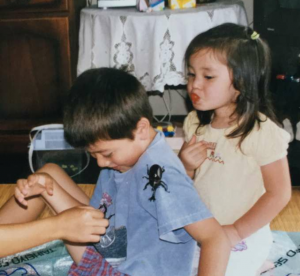Microreading: Deception of the Reader in “Take Your Choice”
Aliens, robots, and biological manipulations– these are all common themes found throughout science fiction stories. Many of these stories take place in future settings, as does the plot of “Take Your Choice” by Sakyo Komatsu (1989). At the beginning we are brought into a future world that is not overly distinct from ours. However, through the subtle build-up of lies told by the scamming time-machine men, not only does the protagonist gain trust for an unrealistic technological advancement of the society but the reader is also dragged into the illusion that choosing your future is possible. Yet, Komatsu’s destruction of the façade of time travel in the end of the story makes the reader realize that the world of “Take Your Choice” is not very different from ours, and the danger of exploiting technology for profit becomes harrowingly real.
The story starts with a setting only slightly more technologically advanced from present-day Earth, in which “two-dimensional TV sets” are “considered almost antique”, “electron-glass eye[s]” are worn by the blind, and “hidden ion air-cleaning device[s]” filtering basements (Komatsu, p. 86-87)– all not impossible to conceive. The extent of futuristic evolution is further established by the protagonist having “two million five hundred thousand credits” in his wallet– indicating inflation and a new currency (Komatsu, p. 89). At this point the reader is under an impression that this is an accurate representation of a world several decades from now.
The reader quickly loses relatability once the protagonist finds himself in a store that claims to be a portal to a new future through time travel. The two men running the store present themselves as not “people of this present world” and are “escapees or violators of the time traveler control laws in [their] world” (Komatsu, p. 90). Hints of doubt are apparent in the protagonist’s voice, but phrases such as “Time Authorities” and “Time Travel Control Department” create an authentic air (Komatsu, p. 90). To fully win the protagonist’s trust over, the little man in charge of the machine uses “non-Euclidian geometry” and other math theories to make it seem that the technology was too advanced for the protagonist to comprehend (Komatsu, p. 90 and 92).
By this part of the story, not only the protagonist but the reader is also convinced of the legitimacy of the time machine. We buy into the scheme of the three different futures the protagonist could travel to: one with highly advanced technology and city planning, another with bucolic lifestyle with people of perfect looks, and a third similar to the protagonist’s current world but one met with a nuclear apocalypse (Komatsu, p. 93-96). To the surprise of the little man, the protagonist chooses the last option (Komatsu, p. 98). Once we see the protagonist enter the time machine chamber, Komatsu describes how “the floor of the passage abruptly became soft like jelly” and how “[the protagonist] felt peculiar vibrations all around him” while experiencing “a painful headache and giddiness” (Komatsu, p. 99). Once the protagonist exits, it seems even more realistic after he notices the other two doors had vanished as the little man had promised (Komatsu, p. 100). The protagonist is relieved that he has escaped the “infinite repetition of daily life” (Komatsu, p. 101), and the reader is fully convinced of the transition as well.
This illusion is quickly destroyed in the final section of the story. The two men running the front brag about how much money they have made from their scam (Komatsu, p. 102). The men had been using normal science fiction movies to depict the three scenes, sending anesthetic gas into the time machine room to disorient anyone inside, and covering the other two doors with carpets upon the protagonist’s exiting (Komatsu, p. 102-103). Initially the two men are comfortable with their set-up, since the customers are ordered to stay quiet about their transitions (Komatsu, p. 102). However, when the little man brings up how most customers choose the apocalyptic option, there is a chilling realization; many of the people choosing the third option were “officials, officers, politicians…” (Komatsu, p. 103). If people- especially those in power- become apathetic thinking that the world will end in several years, regulations and the way of life can spiral down to chaos and use of atomic weapons could become normalized. Even though choosing one’s future was a fake ploy, suddenly the possibility for the dystopic world met with a nuclear apocalypse becomes real.
To the reader, this regression from an unfathomable future to one that is plausible is startling. So much of science fiction is overly imaginative that we often distance ourselves from the morals as being relevant to us. We realize the plot of this story could have been placed in our present world without much awkwardness, and a message is driven home: as the man of the store states, “people have a strong desire for destruction”, and the exploitation of this human trait can lead to disastrous consequences (Komatsu, p. 103).
Works Cited
Komatsu, Sakyo. “Take Your Choice” (1989). Ed. John L. Apostolou and Martin H. Greenberg.
The Best Japanese Science Fiction Stories. New York: Dembner Books, 1989. 85-103.


